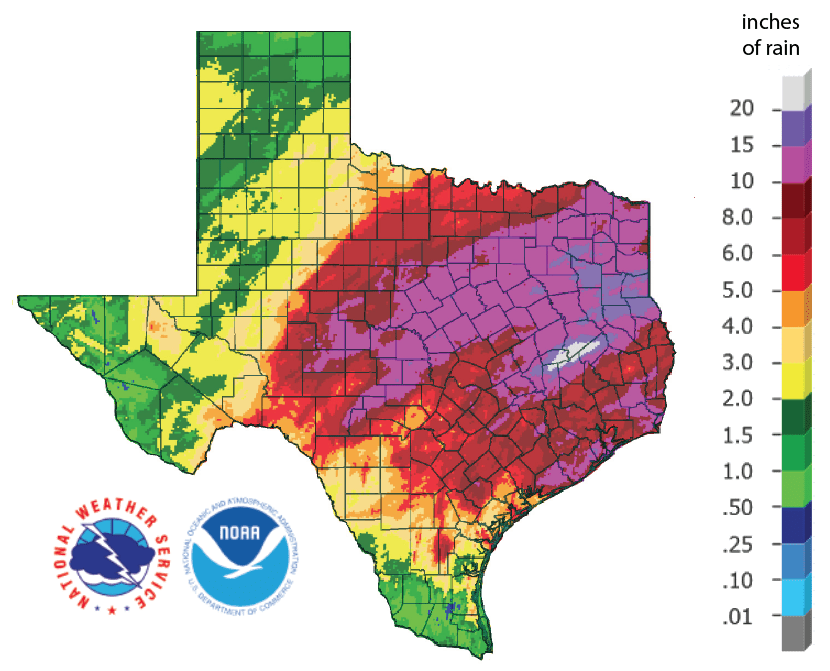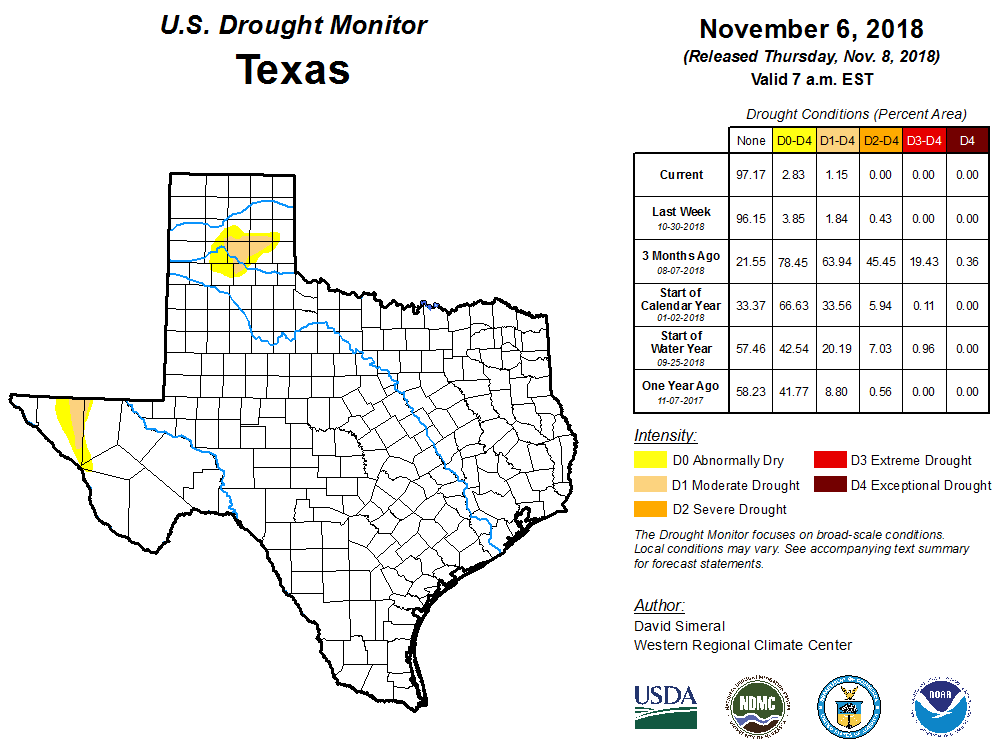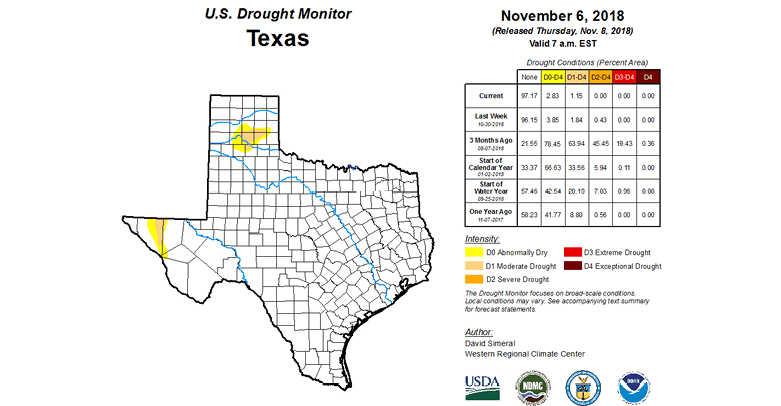SUMMARY:
- October was another rain-filled month for much of Texas.
- Drought is down to affecting only 1 percent of the state.
- Statewide reservoir storage is close to exceeding the highest percentages since at least 1990.
- The odds of El Niño paying a visit are up to 80 percent for this winter.
One thing I learned over the past month is that I would die from dysentery during a boil water notice if a
cryptosporidium passed through my faucet. In case you missed it, epic flooding on the Llano River filled
Lake Travis and the Colorado River with enough suspended solids to shut down much of the capacity of
Austin’s water treatment plants. In response, Austin Water issued a week-long boil water notice. Perhaps it was the comfort of home and routine, but I could not for the life of me keep my toothbrush out of the faucet (nor my mouth out of the shower spray). I even put the cat brush on top of the faucet to cause pause, but, without thinking, I would move it out of the way to rinse the brush (and my mouth). Fortunately, the boil water notice was mostly precautionary so all I contracted was deep thinking on how even I take clean water for granted.
Big rains continued through the central and north-eastern parts of the state with large areas again
receiving more than 10 inches of precipitation over the past 30 days and an area in East Texas suffering
more than 15 inches (Figure 1a). Big rains edged into West Texas filling Oak Creek Reservoir for the first
time since 2008 (Figure 1b) and Lake Sweetwater since, perhaps, the late 1950s (Figure 1c). O.H. Ivie is
now the highest it’s been since 2009 (Figure 1d).

Figure 1a: Inches of rain that fell in Texas in the 30 days before November 12, 2018 (source).

Figure 1b: Storage in Oak Creek Reservoir since the 1950s (source). Current storage is at about 41,000 acre-feet (100 percent full).

Figure 1c: Storage in Lake Sweetwater since the 1940s (source). Current storage is at about 12,400 acre-feet (100 percent full).

Figure 1d: Storage in O.H. Ivie Reservoir since the 1990s (source). Current storage is at about 245,000 acre-feet (44.1 percent full).
The amount of drought in Texas (D1-D4) over the past month has decreased from 12 percent to 1 percent; however, small parts of West and Far West Texas are still suffering from moderate drought conditions (Figure 2a). We saw improvements in drought conditions of one to three classes across most of the state (Figure 2b).

Figure 2a: Drought conditions in Texas according to the U.S. Drought Monitor (as of November 6, 2018; source).

Figure 2b: Changes in the U.S. Drought Monitor for Texas between October 9, 2018, and November 6, 2018 (source).
Ninety-day rainfall deficits improved with sizable parts of the state with at least twice as much rainfall as normal (Figure 3). Even with all the recent rains, there are still widely-distributed splotches of the Rio Grande Valley, the High Plains, and Far West Texas where rainfall is below normal.

Figure 3: Rainfall as a percent of normal for the past 90 days (as of November 12, 2018; source).
The North American Drought Monitor for the end of September shows continuing drought in the headwaters of the Rio Grande in southern Colorado, the primary source of water for Elephant Butte Reservoir, and no drought in North-Central Mexico, the primary source of water for lakes Amistad and Falcon (Figure 4a). Parts of southern Colorado in the Rio Grande watershed have received less than 5 percent of normal precipitation for the past 90 days (Figure 4b).

Figure 4a: The North American Drought Monitor for September 30, 2018 (source).

Figure 4b: Percent of normal rainfall for the past 90 days for the continental United States as of November 12, 2018 (source).
Persistent rains have lifted statewide reservoir storage from 84.3 percent full on October 17th to 88.0 percent on November 12th (Figure 5a), nearly the highest level for this time of year since 1990. The filling of reservoirs has nicely migrated to the west (compare Figure 5b, this month, to Figure 5c, last month) where many reservoirs have been low for over a decade.

Figure 5a: Statewide reservoir storage since 2016 compared to statistics (median, min, and max) for statewide storage since 1990 (source).

Figure 5b: Reservoir storage as November 12, 2018, in the major reservoirs of the state. (source)
 Figure 5c: Reservoir storage as November 12, 2018, in the major reservoirs of the state. (source)
Figure 5c: Reservoir storage as November 12, 2018, in the major reservoirs of the state. (source)
Despite the 70- to 75-percent chance, El Niño didn’t arrive in the fall (believe it or not), but we remain under an El Niño Watch for the winter (~80-percent chance, up from 70 to 75 percent last month) and in the spring (55- to 60-percent chance). The consensus projection shows El Niño conditions arriving this winter and then weakening through the spring (Figure 6). El Niños generally result in wetter-than-normal and cooler-than-normal conditions for Texas and act as a tropical storm suppressor.

Figure 6. Forecasts of sea surface temperatures anomalies for the Niño 3.4 Region as of November 8, 2018 (modified from source).
The U.S. Seasonal Drought Outlook through January 2019 suggests drought improvements in southern Colorado, something that would be welcome for Elephant Butte Reservoir (Figure 7).

Figure 7: The U.S. Seasonal Drought Outlook for October 18, 2018, through January 31, 2019 (source).

